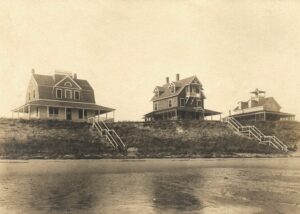WELLFLEET — Two historic cottages will soon look more like they did when they were built at the turn of the 20th century. Both houses have interesting history associated with their early owners, and proposed changes to their exteriors were reviewed recently by the historical commission because they involved partial demolition. But both were approved unanimously by the commission at its Dec. 11 meeting.

One, a Colonial Revival shingled cottage built around 1900 by Lorenzo Dow Baker at 65 Chequessett Bluff Road, is among a group of cottages that were part of his inn at what was then a wharf just west of what is now Mayo Beach. The other is a Queen Anne cottage built in 1905 at 156 Pleasant Point Road overlooking Blackfish Creek. It is one of several built during a boom in summer house construction.
A Baker Cottage on the Bluff
The image of this cottage as seen from Wellfleet Harbor was captured for posterity in a watercolor painted by Edward Hopper in 1933. The house, along with some adjacent cottages on Chequessett Bluff, was built at a time when interest in Wellfleet as a tourist destination was growing. The late local historian Helen Purcell wrote in 1984 that the cottage was still owned by the Baker family. The living room, she wrote, was furnished with pieces that had originally been used in the lobby of the Chequessett Inn.
“Old family photographs decorate the walls of the house, and trunks from Jamaica, where the banana business was carried on, can still be found in the attic,” Purcell wrote about the cottage.
Baker, born on Bound Brook Island in 1840, was an entrepreneur and probably the wealthiest person in Wellfleet in his time.
As captain of the schooner Telegraph, Baker transported people and goods from New England to points south. He was the first to introduce bananas in the U.S., following an unplanned stop in Jamaica in 1870. The banana trade became brisk. Eventually known as the “Banana King,” Baker started an importing business with a Boston partner, which he called the Boston Fruit Company — later United Fruit.
Baker was a mover and shaker in the burgeoning Outer Cape tourist industry, purchasing the 400-foot Mercantile Wharf and constructing a 62-room inn on it in 1865, then building a handful of nearby cottages for guests and staff on Chequessett Bluff Road overlooking the harbor.
Severely damaged in an ice storm in 1934, the inn was demolished, but the summer cottages still stand on the nearby bluff above Mayo Beach.
David Arthur of Boston-based ART Architects designed the proposed changes to the cottage at 65 Chequessett Bluff Road, which he presented to the historical commission on Dec. 11. The property, owned by Cambridge resident Pilar Iglesias, had already been deemed historically significant by the commission. And because the proposal called for partial demolition, the commissioners had the authority to delay the project for up to 18 months if they determined that the changes would affect the property’s historical significance.
Arthur told the commissioners that the renovation would result in a return to the original appearance of the cottage — at least as far as how it looked from the harbor. “Everyone is used to seeing the house from the water, and it will look essentially the same,” Arthur said.
Plans call for demolition of a wing that includes a shed and a garage, which had been a later addition, and replacement of solid panels on the porch with balustrades fashioned after the originals. The vinyl-clad windows will be replaced with double-hung two-over-two windows similar to the originals. A lead-paned rectangular window and a crescent-shaped window, decorative elements on the south side, which faces the water, will be removed, cleaned, and reinstalled.
Since the property owner now plans to use the house year-round, Arthur said, an addition has been planned for the rear of the house that faces the driveway, to accommodate a laundry room, a bathroom, and a den. Plans call for extending the porch, which currently runs on three sides of the house, to areas on both sides of the addition. The addition is not visible from the harbor side of the cottage, Arthur said.
“The goal is to breathe new life into this historic home, while also making it function the way the family lives,” the architect said.
The commission unanimously agreed that the changes would not affect the historic significance of the house and accepted the project as proposed. “The view from the bay will be more similar to what it was when Hopper painted it,” said chair Merrill Mead-Fox.
A Bayside Summer Cottage
Built in 1905, this Queen Anne-style house overlooking Blackfish Creek was part of a summer cottage development. Henry Rapp, born in Syracuse, N.Y. to German immigrant parents, moved to Wellfleet in 1908 with his wife, Cecelia. In 1909, the couple purchased the cottage at 156 Pleasant Point Road.
Rapp owned a Boston company specializing in gas engines, according to the narrative filed with the Mass. Historical Commission. The couple traveled back and forth between Boston and Wellfleet in their speedboat.
“Perhaps prompted by fear following the attack of a tug and barge by a German U-boat off Orleans in 1918, a South Wellfleet neighbor reported Rapp to the FBI implicating him as a German spy,” says the historical narrative. “The neighbor’s mistrust was apparently linked to Rapp’s German heritage, financial success, and alleged suspicious activities and pro-German comments. The FBI investigated but nothing came of it.”
Robert Johnson and Katherine Alford, New York residents and the cottage’s current owners (both of whom are freelance contributors to the Independent), propose installing a new roof and removing the vinyl siding and replacing it with fiber cement clapboards. Trevor Pontbriand of Orleans-based Aline Architecture, who presented the couple’s proposal, said some exploratory removal of the vinyl was done to determine the condition of the original clapboards underneath. The wood showed a great deal of rot. “We believe all of it will have to come off,” Pontbriand said.
Other changes include enclosing an existing screened porch to enlarge the indoor dining area and adding to an existing deck on the harbor side of the house. To address the lack of an entry from the driveway area, Pontbriand proposed an addition that would enclose a stairwell.
The historical commission accepted the proposed changes, saying they would not significantly affect the historic value of the house. Chair Mead-Fox called the proposal “a very reasonable plan,” and added “taking off the vinyl siding is such a wonderful improvement.”



